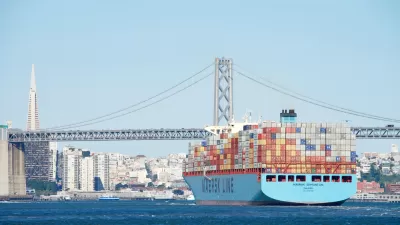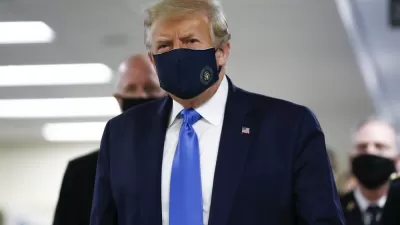Words matter. Road safety advocates know that "crashes are not accidents." Similarly, calling coronavirus restrictions "lockdowns," fails to distinguish the severity among public health orders. On January 6, America experienced a true lockdown.

In the U.S., the term "lockdown," has been applied to almost any restriction that a state or local government imposes on residents, businesses and services within its jurisdiction to mitigate transmission of the coronavirus. What's often lost is that the term refers to an extreme measure taken during emergencies to protect people's safety. The word is derived from a protocol applied to prisons to prevent people from leaving a restricted area.
On Jan. 23, Emily Feng, NPR's Beijing correspondent, reported on the one-year anniversary of the commencement of the world's first and most severe coronavirus lockdown to halt the spread of the novel coronavirus now responsible for over 2 million deaths and nearly 100 million cases, according to the Johns Hopkins Coronavirus Resource Center. A 5-minute audio version is attached to the source article.
For more than two months, nearly all of [Wuhan's] 11 million residents could not leave their apartments. Anyone displaying symptoms was taken to hastily-built quarantine centers to prevent family infections.
The legacy of the lockdown has splintered Wuhan's residents, who have conflicting memories of those 76 days.
Many health experts say a Wuhan lockdown should have begun earlier and would have slowed down the virus' spread. This volunteer [from Wuhan who delivered medical supplies and food during the lockdown and requested anonymity] says nonetheless, he cannot forgive the cost it placed on the city's residents - a cost he feels other Chinese citizens do not grasp: "The lockdown created a run on medical resources and a sense of panic. Many people with conditions other than the coronavirus could not get care as a result and died during lockdown."
The World Health Organization recognizes the costs and benefits of what have come to generically be called lockdowns in their discussion last month of "Herd immunity, lockdowns and COVID-19."
Large scale physical distancing measures and movement restrictions, often referred to as ‘lockdowns’, can slow COVID‑19 transmission by limiting contact between people.
However, these measures can have a profound negative impact on individuals, communities, and societies by bringing social and economic life to a near stop. Such measures disproportionately affect disadvantaged groups, including people in poverty, migrants, internally displaced people and refugees, who most often live in overcrowded and under resourced settings, and depend on daily labour for subsistence.
U.S. pandemic lockdowns?
America's first "shelter-in-place" order to combat the coronavirus was issued by seven public health officers in the Bay Area on March 16, 2020. Erin Allday, a health reporter for the San Francisco Chronicle, wrote: "The order falls just short of a full lockdown, which would forbid people from leaving their homes without explicit permission."
Almost 7 million residents were encouraged to go outside their homes for recreation as well as to obtain essential needs—no documents were needed to show to police who otherwise might arrest them as was the case with their 11 million counterparts in Wuhan. Three days later, all 40 Californians were ordered to "stay-at-home."
American lockdowns
Well before the first case of coronavirus infection was found in Snohomish County, Washington one year ago, lockdowns had sadly become a frequent occurrence due to the uniquely American epidemic of gun violence. The Washington Post determined in December 2018 that millions of American children experienced over 6,200 school lockdowns resulting from the threat of school shootings or other violence, leaving many children traumatized.
On January 6, the world witnessed a lockdown in the U.S. capital when a violent Pro-Trump mob stormed the Capitol building to prevent the counting and confirmation of each state’s electoral votes to finalize the election of former Vice President Joe Biden as the 46th president of the U.S. At about 2:15 p.m., "the Capitol building was placed on lockdown after the demonstrators surged past barricades and law enforcement toward the legislative chambers," reported The New York Times.
Legislators were locked down for hours in the Capitol, unable to leave for their own safety, unlike less restrictive shelter-in-place and stay-at-home orders that have aroused pro-Trump opponents, many from the right-wing extremist groups that participated in the Jan. 6 insurrection. The contrast goes even further as the lockdown may have been the reason for several congress members contracting the virus, according to The Atlantic.
So far, a total of six lawmakers have tested positive after last week’s attack, including the 75-year-old cancer survivor Bonnie Watson Coleman. In refusing to wear masks, Republicans created “a superspreader event on top of a domestic terrorist attack,” Rep. Pramila Jayapal said in a statement announcing her diagnosis.
However, contracting the virus during lockdown is also a reminder of the severity of the Wuhan lockdown—people died as they were unable to obtain medical services.
D.C. statehood?
Another lockdown of sorts occurred after the Jan. 6 insurrection to ensure the safety of the inauguration of then-President-elect Joe Biden and Vice President-elect Kamala Harris that has renewed calls for statehood for the District of Columbia, reports Kriston Capps for Bloomberg CityLab on Jan. 20.
Since supporters of former President Donald Trump sacked the U.S. Capitol building on Jan. 6, a near-total lockdown descended on the city. Buses and heavy trucks at intersections formed a fortified perimeter around downtown, closing stores and businesses and disrupting daily life for stressed-out District residents. The extraordinary military presence during what has traditionally been a week of citywide festivities is just one more nerve-wracking reminder that those who call Washington home are not invited to participate in the decisions shaping the city.
Since the riot at the Capitol on Jan. 6, statehood has emerged as an urgent priority for D.C. residents. The shock of that incident — especially the lack of precautions taken by federal authorities to prepare for an attack that had been openly planned — has reinvigorated local calls for full representation in Congress.
Unlike state governors, the mayor of the District is unable to directly call on the National Guard.
"D.C. Mayor Muriel Bowser asked on Dec. 31 for a National Guard presence in advance of Jan. 6, and she received a limited force to assist primarily with traffic flow," adds Capps.
“What that week shows, or what it should show more people, is that statehood is not some theoretical little nicety,” says D.C. Ward 6 Council member Charles Allen, who represents Capitol Hill and other neighborhoods around the National Mall. “It’s about life and death. It is an absolute necessity.”
Related in Planetizen:
-
Germany Locks Down to Protect Healthcare System, December 15, 2020
-
England Begins Second Lockdown to Protect the National Health Service, November 8, 2020
-
Herd Immunity Finds Receptive Audience in White House and Florida [anti-lockdown activists promote herd immunity through natural infection], Oct.18, 2020
-
Learning from Down Under, July 15, 2020
-
Bay Area Ordered to Shelter in Place, March 17, 2020
- A Nation of 60 Million on Lockdown, March 11, 2020
-
Inauguration Puts D.C. in Crowd Control Mode, January 6, 2009
FULL STORY: Life In Wuhan, One Year After The COVID-19 Outbreak Began

Alabama: Trump Terminates Settlements for Black Communities Harmed By Raw Sewage
Trump deemed the landmark civil rights agreement “illegal DEI and environmental justice policy.”

Planetizen Federal Action Tracker
A weekly monitor of how Trump’s orders and actions are impacting planners and planning in America.

The 120 Year Old Tiny Home Villages That Sheltered San Francisco’s Earthquake Refugees
More than a century ago, San Francisco mobilized to house thousands of residents displaced by the 1906 earthquake. Could their strategy offer a model for the present?

Ken Jennings Launches Transit Web Series
The Jeopardy champ wants you to ride public transit.

BLM To Rescind Public Lands Rule
The change will downgrade conservation, once again putting federal land at risk for mining and other extractive uses.

Indy Neighborhood Group Builds Temporary Multi-Use Path
Community members, aided in part by funding from the city, repurposed a vehicle lane to create a protected bike and pedestrian path for the summer season.
Urban Design for Planners 1: Software Tools
This six-course series explores essential urban design concepts using open source software and equips planners with the tools they need to participate fully in the urban design process.
Planning for Universal Design
Learn the tools for implementing Universal Design in planning regulations.
Clanton & Associates, Inc.
Jessamine County Fiscal Court
Institute for Housing and Urban Development Studies (IHS)
City of Grandview
Harvard GSD Executive Education
Toledo-Lucas County Plan Commissions
Salt Lake City
NYU Wagner Graduate School of Public Service





























